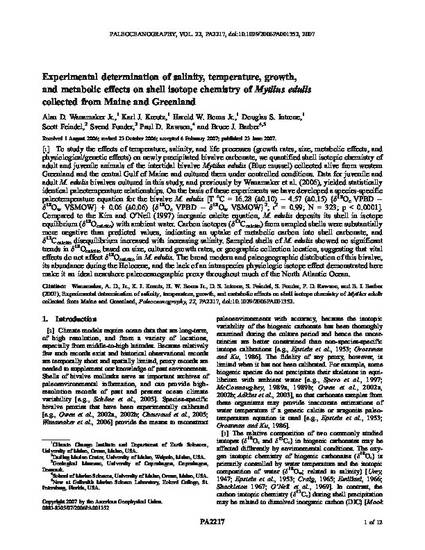
To study the effects of temperature, salinity, and life processes (growth rates, size, metabolic effects, and physiological/ genetic effects) on newly precipitated bivalve carbonate, we quantified shell isotopic chemistry of adult and juvenile animals of the intertidal bivalve Mytilus edulis (Blue mussel) collected alive from western Greenland and the central Gulf of Maine and cultured them under controlled conditions. Data for juvenile and adult M. edulis bivalves cultured in this study, and previously by Wanamaker et al. (2006), yielded statistically identical paleotemperature relationships. On the basis of these experiments we have developed a species-specific paleotemperature equation for the bivalve M. edulis [T degrees C = 16.28 (+/- 0.10) -4.57 (+/- 0.15) {delta(18)O(c) VPBD - delta(18)O(w) VSMOW} + 0.06 (+/- 0.06) {delta(18)O(c) VPBD - delta(18)O(w) VSMOW}(2); r(2) = 0.99; N = 323; p < 0.0001]. Compared to the Kim and O'Neil (1997) inorganic calcite equation, M. edulis deposits its shell in isotope equilibrium (delta(18)O(calcite)) with ambient water. Carbon isotopes (delta(13)C(calcite)) from sampled shells were substantially more negative than predicted values, indicating an uptake of metabolic carbon into shell carbonate, and delta(13)C(calcite) disequilibrium increased with increasing salinity. Sampled shells of M. edulis showed no significant trends in delta(18)O(calcite) based on size, cultured growth rates, or geographic collection location, suggesting that vital effects do not affect delta(18)O(calcite) in M. edulis. The broad modern and paleogeographic distribution of this bivalve, its abundance during the Holocene, and the lack of an intraspecies physiologic isotope effect demonstrated here make it an ideal nearshore paleoceanographic proxy throughout much of the North Atlantic Ocean.
Available at: http://works.bepress.com/karl_kreutz/21/
